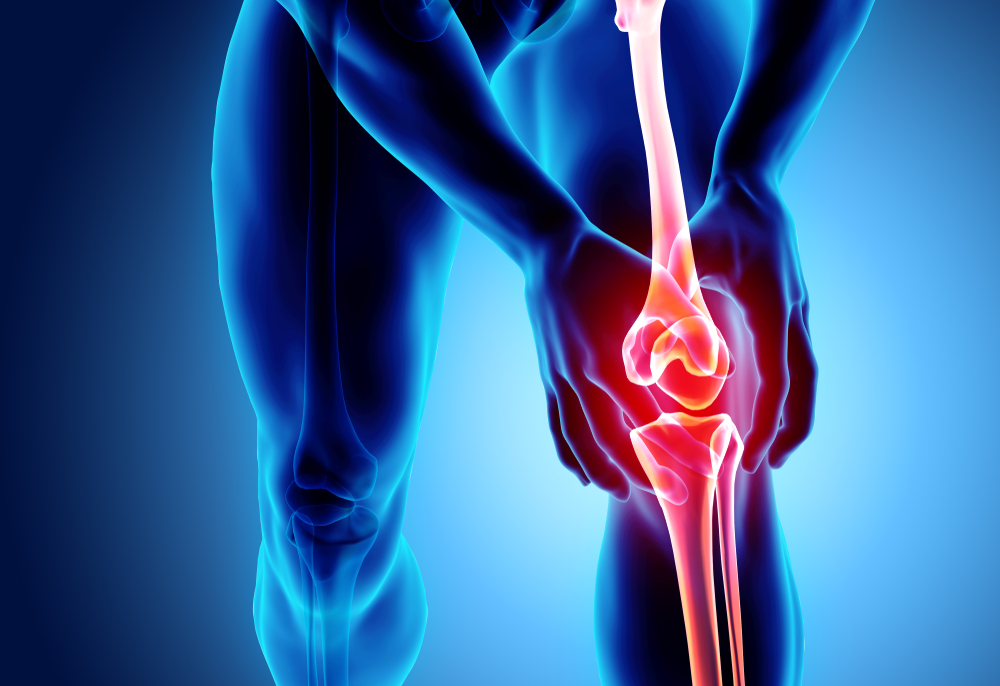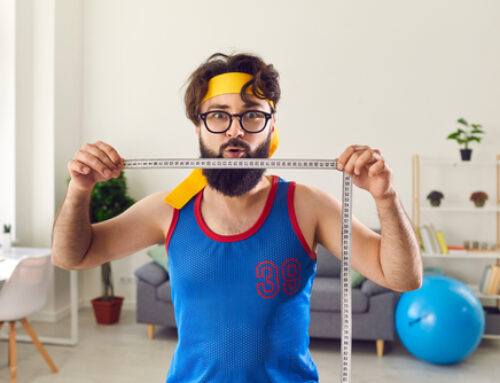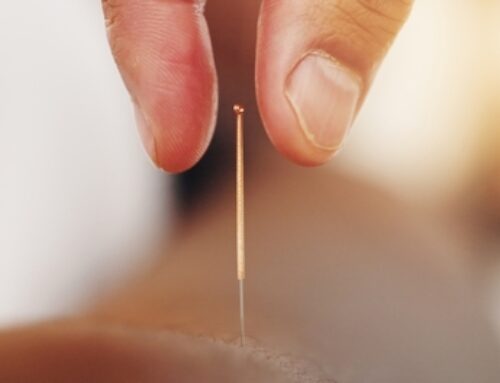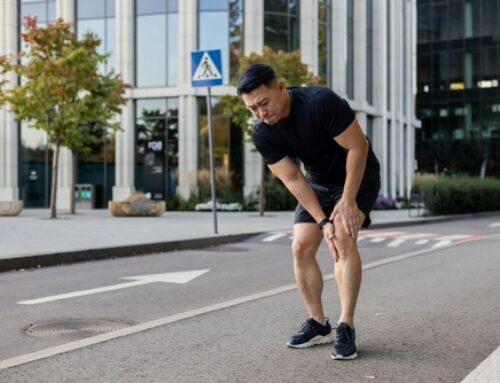Anterior knee pain, Patella pain, and runner’s knee are all names for the formally diagnosed conditions known as patellofemoral ligament pain or patellar chondromalacia. This pain is commonly felt above, under, or below the knee cap. This achy and sharp pain is made worse when going up and down stairs, squatting, after sitting or driving for prolonged periods of time, and of course, with running. Surprisingly, this pain often improves with consistent, low impact movement like walking on flat ground or working in the yard. Patellofemoral pain is not caused by an increase in age or activity. Instead, it is caused by an imbalance of the muscles found around the hip creating an improper load on the patellar ligament when walking, running, or after prolonged sitting.
Every mobility issue, tight muscle, or stuck joint is really an underlying stability issue. If one muscle (even just part of it) is dysfunctional, the whole stabilizing function and movement is compromised. Stiffness of the knee or hip will hide a stability problem somewhere else and can cause altered motion at the patella. The inefficiency of the imbalanced movement eventually overloads the supporting tissue around the knee and leads to injury and pain.
In the case of patellar pain, the stability issue can begin in the core, hip, or knee. Most often the instability begins in the core with reduced intra-abdominal pressure that fails to stabilize the lumbar spine. To compensate, the hip flexors (psoas, rectus femoris, etc.) will over-tighten and simultaneously inhibit glute activation. Reduced glute strength creates a lack of hip stability and consequently, it reduces knee stability. The tightness of the rectus femoris muscle and the other muscles in the quadriceps group create increased tensile load on the patellofemoral ligament, resulting in injury and pain.
So how do we fix it?
Here is the [CORE] Recipe:
1. Active Release Technique 2. Acupuncture 3. Chiropractic 4. DNS Rehab Exercises.
Active Release Technique (ART):
ART is a patented soft-tissue technique used at [CORE] to reverse the compensation pattern and scar tissue formation seen around the injured area. ART can help to not only reduce pain but can also aid in the reduction of the muscle imbalance found at the hip and knee. This technique is a powerful tool to help the athlete eliminate Runner’s knee pain and to reinstate their training program. To learn more about ART, check out our previous article on ART and Endurance Athletes.>>
Acupuncture:
Acupuncture is another highly effective tool used to reduce the pain of stubborn patellofemoral pain. Some practitioners use acupuncture needles to perform dry needling on tendons to elicit an immune response to help facilitate tissue healing. At [CORE], we combine this technique with acupuncture points to enhance the pain reducing effects of the procedure. If you want to learn more about these techniques, read our article on the Differences between Dry Needling and Acupuncture.>>
Chiropractic:
Chiropractic is an essential part of eliminating the pain created by patellofemoral pain. Chiropractic treatment is specifically designed to improve the efficiency of movement. “When the knees are hurting, look to the hips,” was a saying that was drilled into me during chiropractic school. This has proven to be true with nearly every knee pain patient. The chiropractic adjustment to the SIJ joint and lumbar spine can help to improve the movement dysfunction between these joints and the knees. Unfortunately, the adjustment works so well to improve pain that it has caused many practitioners to become idle and fail to teach patients the root cause of their condition. Lifestyle factors like prolonged sitting and sleeping in the fetal position are just a few of the everyday causes of patellofemoral pain. Practitioners should encourage patients to change their lifestyle habits to help prevent the recurrence of pain. Read our article for more information on how chiropractic care can help you Return to running after a hip or knee injury.>>
DNS Rehab Exercises:
Rehabilitation is the key to eliminating painful musculoskeletal conditions. The vast majority of these painful problems are the result of doing the wrong thing over and over again. To prevent this, a change must occur and rehab exercises are the key. Here are three exercises from the DNS (Dynamic Neuromuscular Stabilization) system used to reduce the pain associated with patellofemoral pain.
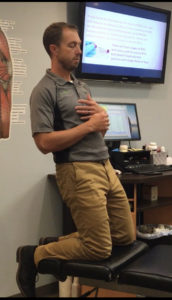
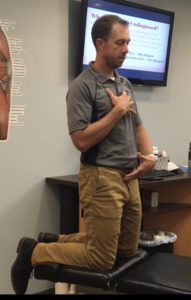
Reverse Nordic
- Begin by kneeling on both knees with feet over the edge of your bed or ottoman.
- With tall posture and bracing through the core, slowly flex the knee as you lean your torso backwards.
- Stop when mild pain is felt near the patella or when you can no longer maintain stability. Return to the starting position.
- Repeat for 15 reps.
High kneel to oblique sit
- Start in a typical one leg kneeling position with the advanced leg bent at 90 degrees at the hip and the knee.
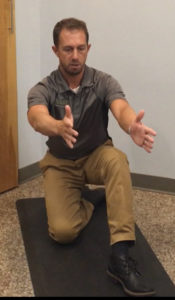
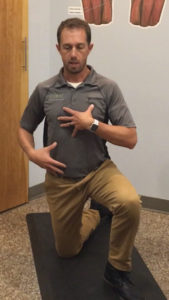
- Open the advanced leg laterally by moving it laterally 20 degrees.
- Move the trailing leg’s ankle medially by externally rotating the hip.
- Rotate the torso and hips to align with the advanced leg.
- Perform the exercise by sitting back over the trailing hip joint. This will quickly load the trailing leg’s quadriceps group.
- Continue to sit back until stability or upright posture are no longer maintained.
- Repeat for 5-10 repetitions.
Egg Touches
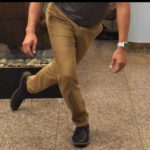
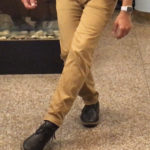
- Start by standing on one slightly bent leg.
- Reach with the non-weight bearing to points on the floor at 2, 10, 4, and 8 o’clock on an imaginary clock face on the ground.
- As if there was an egg on the floor, lightly touch but do not crush the egg.
- This exercise should be performed slowly with great control.
- Advance this exercise by reaching further away from the center at the same points on the clock face.
Check out a video of these exercises here>>
If you have more questions about patellofemoral pain and how the [Core] approach may be able to help you, please contact our office or stop in to see us. Our staff is dedicated to helping you become healthier than you have ever been.
All CBD Clinic Cream is now 10% off for the next two weeks.

Daryl C. Rich, D.C., C.S.C.S.

